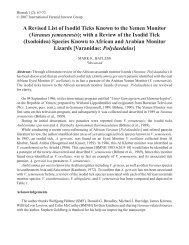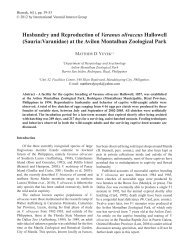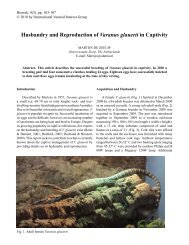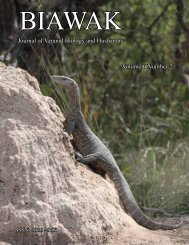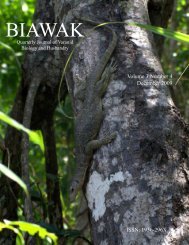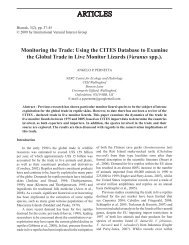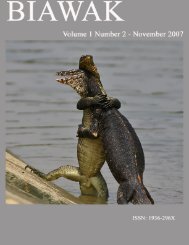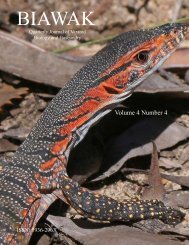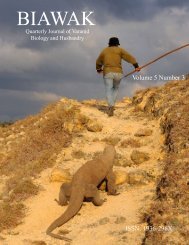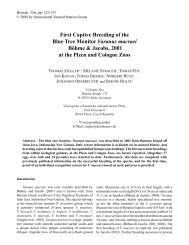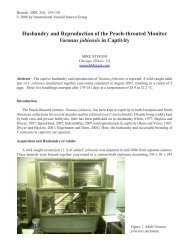Vol. 4 No. 1 - International Varanid Interest Group
Vol. 4 No. 1 - International Varanid Interest Group
Vol. 4 No. 1 - International Varanid Interest Group
You also want an ePaper? Increase the reach of your titles
YUMPU automatically turns print PDFs into web optimized ePapers that Google loves.
17<br />
WEIJOLA - MONITOR LIZARDS OF THE NORTHERN MOLuccAS<br />
Fig. 14. Juvenile V. rainerguentheri. gebe island.<br />
observed in the field and appears to be unique to that<br />
particular specimen. Field investigations of larger<br />
sample sizes also show that the postocular stripe is<br />
variable among Halmaheran and north Moluccan<br />
populations of V. rainerguentheri, and usually fades with<br />
age. For example, the two specimens depicted in Setiadi<br />
and Hamidy (2006) as V. indicus and V. rainerguentheri<br />
appear to only show intraspecific variation, and cannot<br />
be allocated to different species based solely on the<br />
occurrence of a temporal stripe. The temporal stripe is<br />
usually less pronounced on specimens from Obi and<br />
gebe compared to Halmahera and Morotai, though<br />
based on external features, the populations on these<br />
islands are very difficult to distinguish. Specimens from<br />
Obi do appear to have dark pigmentation further back<br />
on the tongue.<br />
Despite the potential weaknesses in the original<br />
description, I have opted to use the name V.<br />
rainerguentheri for populations of the V. indicus-type<br />
monitors in the northern Moluccas included in this<br />
paper. A more detailed taxonomic investigation of<br />
animals from verifiable localities and with larger sample<br />
sizes is much needed to confirm the taxonomy and<br />
specific characteristics of this species, particularly since<br />
the description of V. rainerguentheri failed to make a<br />
comparison with the very similar animals of nearby<br />
Waigeo, which were described as V. chlorostigma<br />
by gray (1831). This name was synonymized with V.<br />
indicus by Böhme et al. (1994) and earlier authors,<br />
but the subsequent redefinition of V. indicus (philipp<br />
et al. 1999) excludes animals from Waigeo on several<br />
characteristics (such as throat markings, tongue color<br />
and scalation). The redefinition of V. indicus invalidates<br />
this earlier synonymization, and makes V. chlorostigma<br />
a potentially available name for V. rainerguentheri.<br />
distribution: Varanus rainerguentheri is widely<br />
distributed, particularly around the coastlines, on<br />
Halmahera, Ternate (RMNH voucher), Tidore (MZB<br />
voucher), Morotai, Bacan, Kasiruta, gebe and Obi (and<br />
probably on many of the smaller islands of this region).<br />
ecology: One hundred and twelve (112) observations<br />
were made during the course of fieldwork. On all<br />
islands except gebe, they are mostly restricted to<br />
coastal areas and mangrove swamps (Tables 1 and 2).



